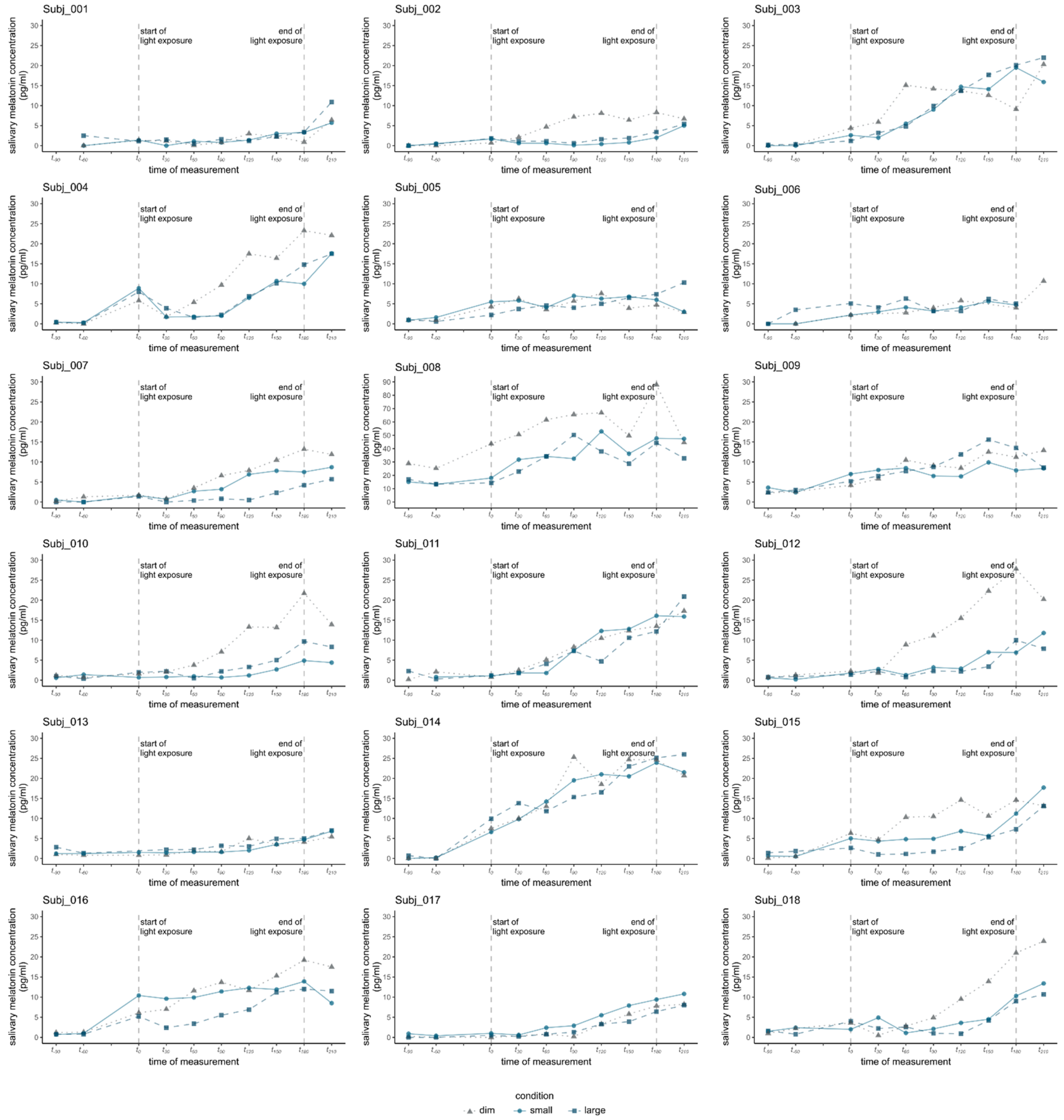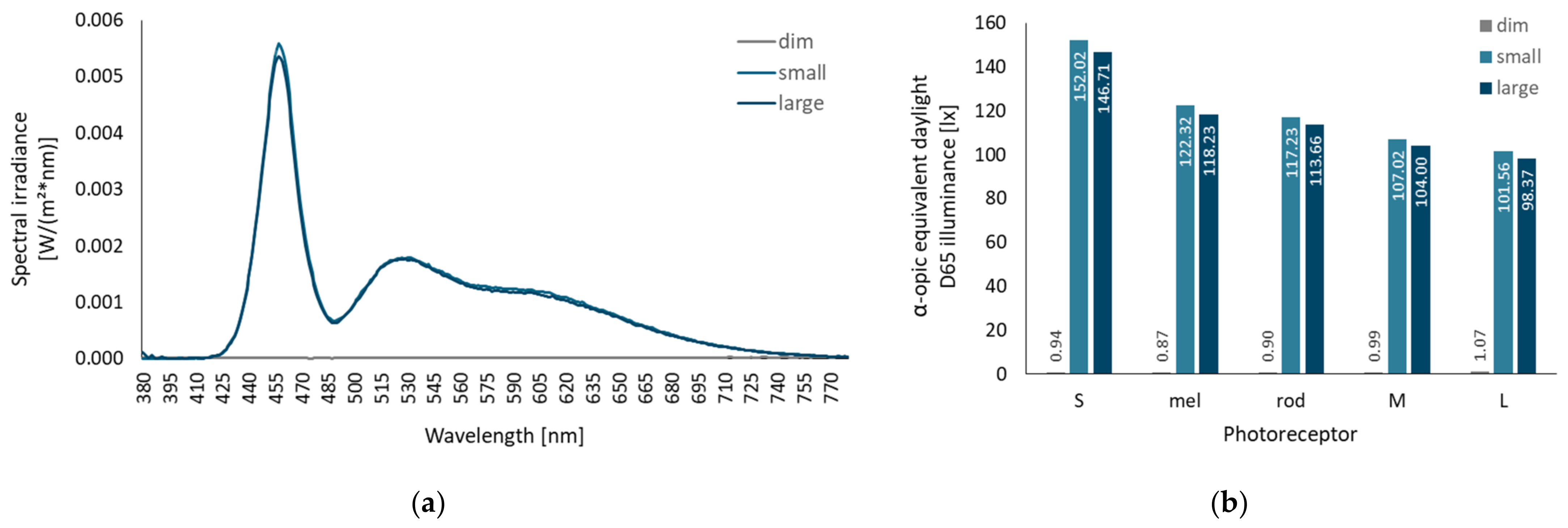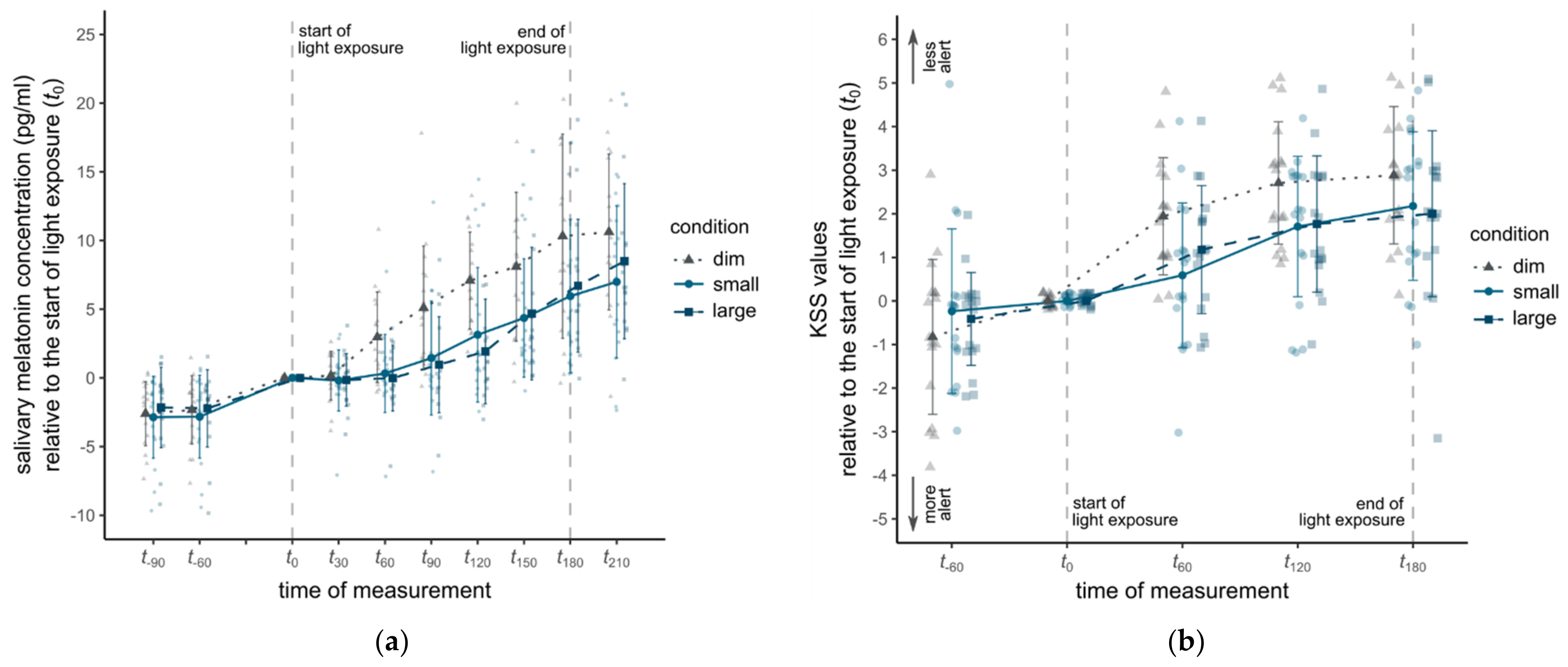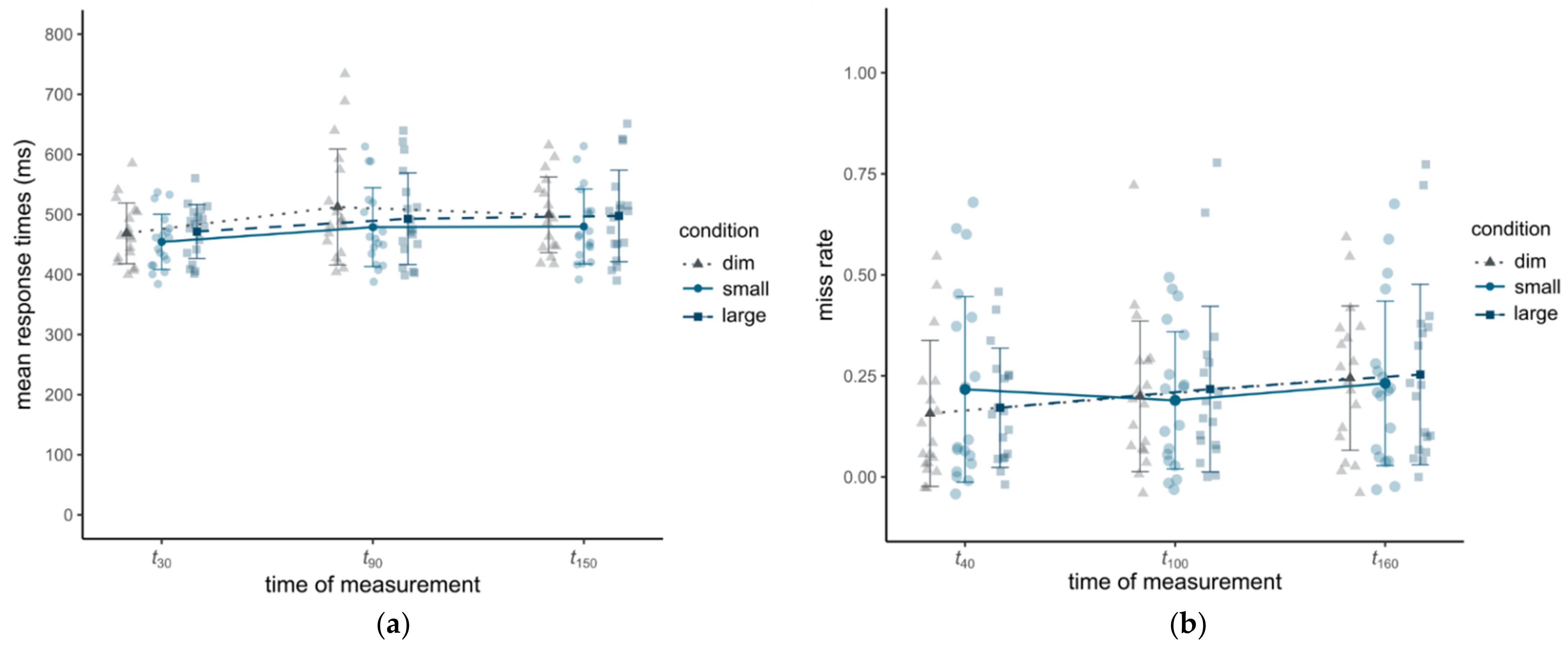Impact of Evening Light Exposures with Different Solid Angles on Circadian Melatonin Rhythms, Alertness, and Visual Comfort in an Automotive Setting
Abstract
:1. Introduction
2. Materials and Methods
2.1. Ethical Approval
2.2. Study Participants
2.3. Tasks and Measures
2.4. Procedure
2.5. Experimental Setup and Light Settings
2.6. Statistical Analysis
3. Results
3.1. Salivary Melatonin
3.2. Subjective Alertness
3.3. Cognitive Alertness
3.4. Visual Comfort
4. Discussion
5. Conclusions
Author Contributions
Funding
Institutional Review Board Statement
Informed Consent Statement
Data Availability Statement
Acknowledgments
Conflicts of Interest
Appendix A
| Dim | Small Solid Angle | Large Solid Angle | |
|---|---|---|---|
| photopic illuminance (lx) | 1.06 | 101.96 | 98.94 |
| CCT (K) | 4982 | 12158 | 12146 |
| S-cone-opic irradiance (mW/m2) | 0.76 | 124.24 | 119.90 |
| M-cone-opic irradiance (mW/m2) | 1.44 | 155.80 | 151.40 |
| L-cone-opic irradiance (mW/m2) | 1.73 | 165.42 | 160.23 |
| rhodopic irradiance (mW/m2) | 1.31 | 169.95 | 164.78 |
| melanopic irradiance (mW/m2) | 1.16 | 162.22 | 156.80 |
| mELR (melanopic efficacy of luminous radiation; mW/lm) | 1.09 | 1.59 | 1.58 |
| mDER (melanopic daylight D65 efficancy ratio) | 0.82 | 1.20 | 1.19 |
| mEDI (melanopic equivilant daylight D65 illuminance; lx) | 0.87 | 122.32 | 118.23 |
Appendix B


References
- Cajochen, C. Alerting effects of light. Sleep Med. Rev. 2007, 11, 453–464. [Google Scholar] [CrossRef] [PubMed]
- Souman, J.L.; Tinga, A.M.; Te Pas, S.F.; van Ee, R.; Vlaskamp, B.N.S. Acute alerting effects of light: A systematic literature review. Behav. Brain Res. 2018, 337, 228–239. [Google Scholar] [CrossRef] [PubMed]
- Aschoff, J. Exogenous and Endogenous Components in Circadian Rhythms; Cold Spring Harbor Laboratory Press: New York, NY, USA, 1960; ISBN 0091-7451. [Google Scholar]
- Tähkämö, L.; Partonen, T.; Pesonen, A.-K. Systematic review of light exposure impact on human circadian rhythm. Chronobiol. Int. 2019, 36, 151–170. [Google Scholar] [CrossRef] [Green Version]
- Graham, D.M.; Wong, K.Y. Melanopsin-expressing, intrinsically photosensitive retinal ganglion cells (ipRGCs). In Webvision: The Organization of the Retina and Visual System [Internet]; University of Utah Health Sciences Center: Salt Lake City, UT, USA, 2016. [Google Scholar]
- Nasir-Ahmad, S.; Lee, S.C.S.; Martin, P.R.; Grünert, U. Melanopsin-expressing ganglion cells in human retina: Morphology, distribution, and synaptic connections. J. Comp. Neurol. 2019, 527, 312–327. [Google Scholar] [CrossRef] [Green Version]
- Hattar, S.; Liao, H.W.; Takao, M.; Berson, D.M.; Yau, K.W. Melanopsin-containing retinal ganglion cells: Architecture, projections, and intrinsic photosensitivity. Science 2002, 295, 1065–1070. [Google Scholar] [CrossRef] [Green Version]
- Brzezinski, A. Melatonin in humans. N. Engl. J. Med. 1997, 336, 186–195. [Google Scholar] [CrossRef] [PubMed]
- Cajochen, C.; Kräuchi, K.; von Arx, M.-A.; Möri, D.; Graw, P.; Wirz-Justice, A. Daytime melatonin administration enhances sleepiness and theta/alpha activity in the waking EEG. Neurosci. Lett. 1996, 207, 209–213. [Google Scholar] [CrossRef]
- Lewy, A.J. Effects of light on human melatonin production and the human circadian system. Prog. Neuro-Psychopharmacol. Biol. Psychiatry 1983, 7, 551–556. [Google Scholar] [CrossRef]
- Zhdanova, I.V.; Wurtman, R.J.; Lynch, H.J.; Ives, J.R.; Dollins, A.B.; Morabito, C.; Matheson, J.K.; Schomer, D.L. Sleep-inducing effects of low doses of melatonin ingested in the evening. Clin. Pharmacol. Ther. 1995, 57, 552–558. [Google Scholar] [CrossRef]
- Cagnacci, A.; Elliott, J.A.; Yen, S.S. Melatonin: A major regulator of the circadian rhythm of core temperature in humans. J. Clin. Endocrinol. Metab. 1992, 75, 447–452. [Google Scholar] [CrossRef] [PubMed]
- Lok, R.; van Koningsveld, M.J.; Gordijn, M.C.M.; Beersma, D.G.M.; Hut, R.A. Daytime melatonin and light independently affect human alertness and body temperature. J. Pineal Res. 2019, 67, e12583. [Google Scholar] [CrossRef] [PubMed] [Green Version]
- Cajochen, C.; Stefani, O.; Schöllhorn, I.; Lang, D.; Chellappa, S.L. Influence of evening light exposure on polysomnographically assessed night-time sleep: A systematic review with meta-analysis. Light. Res. Technol. 2022, 257, 147715352210787. [Google Scholar] [CrossRef]
- Stefani, O.; Freyburger, M.; Veitz, S.; Basishvili, T.; Meyer, M.; Weibel, J.; Kobayashi, K.; Shirakawa, Y.; Cajochen, C. Changing color and intensity of LED lighting across the day impacts on circadian melatonin rhythms and sleep in healthy men. J. Pineal Res. 2021, 70, e12714. [Google Scholar] [CrossRef]
- Lockley, S.W.; Evans, E.E.; Scheer, F.A.; Brainard, G.C.; Czeisler, C.A.; Aeschbach, D. Short-Wavelength Sensitivity for the Direct Effects of Light on Alertness, Vigilance, and the Waking Electroencephalogram in Humans. Sleep 2006, 29, 161–168. [Google Scholar] [CrossRef] [PubMed]
- Xu, Q.; Lang, C.P. Revisiting the alerting effect of light: A systematic review. Sleep Med. Rev. 2018, 41, 39–49. [Google Scholar] [CrossRef] [PubMed]
- Smolders, K.C.; de Kort, Y.A. Bright light and mental fatigue: Effects on alertness, vitality, performance and physiological arousal. J. Environ. Psychol. 2014, 39, 77–91. [Google Scholar] [CrossRef]
- Westfal, V.F. Evaluation of Biologically Effective Light in the Vehicle Interior in Terms of Subjective and Objective Parameters of the Driver’s State. Master’s Thesis, University of Twente, Enschede, The Netherlands, 2017. [Google Scholar]
- Shekari Soleimanloo, S. Effects of Light and Caffeine on Human Sleepiness and Alertness: A Simulated Driving Experiment. Doctoral Dissertation, Queensland University of Technology, Brisbane, QLD, Australia, 2016. [Google Scholar]
- Phipps-Nelson, J.; Redman, J.R.; Schlangen, L.J.M.; Rajaratnam, S.M.W. Blue light exposure reduces objective measures of sleepiness during prolonged nighttime performance testing. Chronobiol. Int. 2009, 26, 891–912. [Google Scholar] [CrossRef] [PubMed]
- Weisgerber, D.M.; Nikol, M.; Mistlberger, R.E. Driving home from the night shift: A bright light intervention study. Sleep Med. 2017, 30, 171–179. [Google Scholar] [CrossRef]
- Hartley, S.L.; Barbot, F.; Machou, M.; Lejaille, M.; Moreau, B.; Vaugier, I.; Lofaso, F.; Quera-Salva, M.A. Combined caffeine and bright light reduces dangerous driving in sleep-deprived healthy volunteers: A pilot cross-over randomised controlled trial. Neurophysiol. Clin. 2013, 43, 161–169. [Google Scholar] [CrossRef]
- Landström, U.; Åkerstedt, T.; Byström, M.; Nordström, B.; Wibom, R. Effect on truck drivers’ alertness of a 30-min. exposure to bright light: A field study. Percept. Mot. Ski. 2004, 98, 770–776. [Google Scholar] [CrossRef]
- Leger, D.; Philip, P.; Jarriault, P.; Metlaine, A.; Choudat, D. Effects of a combination of napping and bright light pulses on shift workers’ sleepiness at the wheel: A pilot study. J. Sleep Res. 2009, 18, 472–479. [Google Scholar] [CrossRef] [PubMed]
- Taillard, J.; Capelli, A.; Sagaspe, P.; Anund, A.; Åkerstedt, T.; Philip, P. In-car nocturnal blue light exposure improves motorway driving: A randomized controlled trial. PLoS ONE 2012, 7, e46750. [Google Scholar] [CrossRef] [PubMed] [Green Version]
- Schüler, S.; Rothe, S.; Betz, D.; Schrauf, M.; Popp, R. Integration of a melanopic-light-unit in a truck and investigation of its impact on truck drivers under real-life conditions. In Proceedings of the 12th International Symposium on Automotive Lighting: ISAL 2017; Khanh, T.Q., Ed.; Herbert Utz Verlag GmbH: München, Germany, 2017; pp. 693–702, ISBN 978-3-8316-4671-5. [Google Scholar]
- Schüler, S.; Betz, D.; Popp, R. Biologically Effective Light-Safety behind the Wheel. ATZ Worldw 2020, 122, 16–21. [Google Scholar] [CrossRef]
- Knoop, M.; Broszio, K.; Diakite, A.; Liedtke, C.; Niedling, M.; Rothert, I.; Rudawski, F.; Weber, N. Methods to Describe and Measure Lighting Conditions in Experiments on Non-Image-Forming Aspects. Leukos 2019, 15, 163–179. [Google Scholar] [CrossRef]
- Dacey, D.M.; Liao, H.-W.; Peterson, B.B.; Robinson, F.R.; Smith, V.C.; Pokorny, J.; Yau, K.-W.; Gamlin, P.D. Melanopsin-expressing ganglion cells in primate retina signal colour and irradiance and project to the LGN. Nature 2005, 433, 749–754. [Google Scholar] [CrossRef] [PubMed]
- Gaddy, J.R.; Edelson, M.; Stewart, K.; Brainard, G.C.; Rollag, M.D. Possible retinal spatial summation in melatonin suppression. In Proceedings of the Biologic Effects of Light: Proceedings of a Symposium, Atlanta, GA, USA, 13–15 October 1991; de Gruyter: Atlanta, GA, USA, 1992; p. 196. [Google Scholar]
- Novotny, P.; Paulick, P.; Schwarz, M.J.; Plischke, H. The Solid Angle of Light Sources and Its Impact on the Suppression of Melatonin in Humans. In Proceedings of the International Conference on Human-Computer Interaction, Las Vegas, NV, USA, 21–26 July 2013; Springer: Berlin/Heidelberg, Germany, 2013. ISBN 978-3-642-39473-7. [Google Scholar]
- Niemeyer, A.; Rottmair, L.; Neumann, C.; Möckel, C. Influence of the perceived size of a light source on non-visual effects in humans. Adv. Opt. Technol. 2020, 9, 385–393. [Google Scholar] [CrossRef]
- Åkerstedt, T.; Folkard, S. The three-process model of alertness and its extension to performance, sleep latency, and sleep length. Chronobiol. Int. 1997, 14, 115–123. [Google Scholar] [CrossRef]
- May, J.F.; Baldwin, C.L. Driver fatigue: The importance of identifying causal factors of fatigue when considering detection and countermeasure technologies. Transp. Res. Part F Traffic Psychol. Behav. 2009, 12, 218–224. [Google Scholar] [CrossRef]
- Buysse, D.J.; Reynolds, C.F.; Monk, T.H.; Berman, S.R.; Kupfer, D.J. The Pittsburgh Sleep Quality Index: A new instrument for psychiatric practice and research. Psychiatry Res. 1989, 28, 193–213. [Google Scholar] [CrossRef]
- Griefahn, B.; Künemund, C.; Bröde, P.; Mehnert, P. Zur Validität der deutschen Übersetzung des Morningness-Eveningness-Questionnaires von Horne und Östberg: The Validity of a German Version of the Morningness-Eveningness-Questionnaire Developed by Horne and Östberg. Somnologie-Schlafforschung Schlafmed. 2001, 5, 71–80. [Google Scholar] [CrossRef]
- Ware, J.E.; Sherbourne, C.D. The MOS 36-item short-form health survey (SF-36): I. Conceptual framework and item selection. Med. Care 1992, 30, 473–483. [Google Scholar] [CrossRef] [PubMed]
- Bach, M. The Freiburg Visual Acuity Test-automatic measurement of visual acuity. Optom. Vis. Sci. 1996, 73, 49–53. [Google Scholar] [CrossRef] [PubMed]
- Ishihara, S. Test for Colour-Blindness; Kanehara: Tokyo, Japan, 1987. [Google Scholar]
- Faul, F.; Erdfelder, E.; Lang, A.-G.; Buchner, A. G*Power 3: A flexible statistical power analysis program for the social, behavioral, and biomedical sciences. Behav. Res. Methods 2007, 39, 175–191. [Google Scholar] [CrossRef] [PubMed]
- Åkerstedt, T.; Gillberg, M. Subjective and objective sleepiness in the active individual. Int. J. Neurosci. 1990, 52, 29–37. [Google Scholar] [CrossRef]
- Cajochen, C.; Freyburger, M.; Basishvili, T.; Garbazza, C.; Rudzik, F.; Renz, C.; Kobayashi, K.; Shirakawa, Y.; Stefani, O.; Weibel, J. Effect of daylight LED on visual comfort, melatonin, mood, waking performance and sleep. Light. Res. Technol. 2019, 51, 1044–1062. [Google Scholar] [CrossRef]
- Eklund, N.H.; Boyce, P.R. The development of a reliable, valid, and simple office lighting survey. J. Illum. Eng. Soc. 1996, 25, 25–40. [Google Scholar] [CrossRef]
- Dinges, D.F.; Powell, J.W. Microcomputer analyses of performance on a portable, simple visual RT task during sustained operations. Behav. Res. Methods Instrum. Comput. 1985, 17, 652–655. [Google Scholar] [CrossRef]
- Lichstein, K.L.; Riedel, B.W.; Richman, S.L. The Mackworth Clock Test: A computerized version. J. Psychol. 2000, 134, 153–161. [Google Scholar] [CrossRef]
- Mackworth, J.F. Vigilance and Habituation: A Neuropsychological Approach; Penguin Books: London, UK, 1969; ISBN 0140800956. [Google Scholar]
- CIE S 026/E:2018; CIE System for Metrology of Optical Radiation for ipRGC-Influenced Resposes to Light. International Commission on Illumination: Vienna, Austria, 2018.
- Singmann, H.; Bolker, B.; Westfall, J.; Aust, F.; Ben-Shachar, M.S. afex: Analysis of Factorial Experiments. R Package Version 0.13–145. 2015. Available online: https://mran.microsoft.com/snapshot/2015-05-01/web/packages/afex/index.html (accessed on 24 October 2022).
- Bortz, J.; Schuster, C. Statistik für Human-und Sozialwissenschaftler; Springer: Berlin/Heidelberg, Germany, 2011; ISBN 3642127703. [Google Scholar]
- Geisser, S.; Greenhouse, S.W. An extension of box’s results on the use of the F distribution in multivariate analysis. Ann. Math. Stat. 1958, 29, 885–891. [Google Scholar] [CrossRef]
- Mauchly, J.W. Significance Test for Sphericity of a Normal n-Variate Distribution. Ann. Math. Statist. 1940, 11, 204–209. [Google Scholar] [CrossRef]
- Cajochen, C.; Münch, M.; Kobialka, S.; Kräuchi, K.; Steiner, R.; Oelhafen, P.; Orgül, S.; Wirz-Justice, A. High sensitivity of human melatonin, alertness, thermoregulation, and heart rate to short wavelength light. J. Clin. Endocrinol. Metab. 2005, 90, 1311–1316. [Google Scholar] [CrossRef] [PubMed] [Green Version]
- Giménez, M.C.; Stefani, O.; Cajochen, C.; Lang, D.; Deuring, G.; Schlangen, L.J.M. Predicting melatonin suppression by light in humans: Unifying photoreceptor-based equivalent daylight illuminances, spectral composition, timing and duration of light exposure. J. Pineal Res. 2022, 72, e12786. [Google Scholar] [CrossRef] [PubMed]
- Kaida, K.; Takahashi, M.; Haratani, T.; Otsuka, Y.; Fukasawa, K.; Nakata, A. Indoor exposure to natural bright light prevents afternoon sleepiness. Sleep 2006, 29, 462–469. [Google Scholar] [CrossRef] [PubMed] [Green Version]
- Bromundt, V.; Frey, S.; Odermatt, J.; Cajochen, C. Extraocular light via the ear canal does not acutely affect human circadian physiology, alertness and psychomotor vigilance performance. Chronobiol. Int. 2014, 31, 343–348. [Google Scholar] [CrossRef]
- Maierova, L.; Borisuit, A.; Scartezzini, J.-L.; Jaeggi, S.M.; Schmidt, C.; Münch, M. Diurnal variations of hormonal secretion, alertness and cognition in extreme chronotypes under different lighting conditions. Sci. Rep. 2016, 6, 33591. [Google Scholar] [CrossRef]
- Wright, K.; Badia, P.; Myers, B.; Plenzler, S. Combination of bright light and caffeine as a countermeasure for impaired alertness and performance during extended sleep deprivation. J. Sleep Res. 1997, 6, 26–35. [Google Scholar] [CrossRef]
- Aries, M.; Beute, F.; Fischl, G. Assessment protocol and effects of two dynamic light patterns on human well-being and performance in a simulated and operational office environment. J. Environ. Psychol. 2020, 69, 101409. [Google Scholar] [CrossRef]
- Popp, R.F.J. Gegenmaßnahmen bei Schläfrigkeit: Der Effekt von Kurzwelligem Licht und Olfaktorischer Stimulation. Doctoral Dissertation, Universtiy of Regensburg, Regensburg, Germany, 2006. [Google Scholar]
- Sülflow, D. Zur Wirkung von Kurzwelligem Licht auf Befindlichkeit und Melatoninsynthese bei Gesunden Probanden in den Abendstunden unter Berücksichtigung des Chronotypus und des Geschlechtes. Ph.D. Thesis, Charité, Berlin, Germany, 2013. [Google Scholar]
- Burgess, H.J.; Fogg, L.F. Individual differences in the amount and timing of salivary melatonin secretion. PLoS ONE 2008, 3, e3055. [Google Scholar] [CrossRef] [Green Version]
- Phillips, A.J.K.; Vidafar, P.; Burns, A.C.; McGlashan, E.M.; Anderson, C.; Rajaratnam, S.M.W.; Lockley, S.W.; Cain, S.W. High sensitivity and interindividual variability in the response of the human circadian system to evening light. Proc. Natl. Acad. Sci. USA. 2019, 116, 12019–12024. [Google Scholar] [CrossRef] [Green Version]
- Chellappa, S.L. Individual differences in light sensitivity affect sleep and circadian rhythms. Sleep 2020, 44, zsaa214. [Google Scholar] [CrossRef]
- Waters, C.E.; Mistrick, R.G.; Bernecker, C.A. Discomfort Glare from Sources of Nonuniform Luminance. J. Illum. Eng. Soc. 1995, 24, 73–85. [Google Scholar] [CrossRef]
- Stefani, O.; Cajochen, C. Should We Re-think Regulations and Standards for Lighting at Workplaces? A Practice Review on Existing Lighting Recommendations. Front. Psychiatry 2021, 12, 652161. [Google Scholar] [CrossRef] [PubMed]
- Duffy, J.F.; Cain, S.W.; Chang, A.-M.; Phillips, A.J.K.; Münch, M.Y.; Gronfier, C.; Wyatt, J.K.; Dijk, D.-J.; Wright, K.P.; Czeisler, C.A. Sex difference in the near-24-hour intrinsic period of the human circadian timing system. Proc. Natl. Acad. Sci. USA 2011, 108, 15602–15608. [Google Scholar] [CrossRef] [PubMed] [Green Version]
- Adan, A.; Natale, V. Gender differences in morningness-eveningness preference. Chronobiol. Int. 2002, 19, 709–720. [Google Scholar] [CrossRef]
- Chellappa, S.L.; Steiner, R.; Oelhafen, P.; Cajochen, C. Sex differences in light sensitivity impact on brightness perception, vigilant attention and sleep in humans. Sci. Rep. 2017, 7, 14215. [Google Scholar] [CrossRef] [Green Version]
- Khalsa, S.B.S.; Jewett, M.E.; Cajochen, C.; Czeisler, C.A. A phase response curve to single bright light pulses in human subjects. J. Physiol. 2003, 549, 945–952. [Google Scholar] [CrossRef]
- Cyr, M.; Artenie, D.Z.; Al Bikaii, A.; Borsook, D.; Olson, J.A. The effect of evening light on circadian-related outcomes: A systematic review. Sleep Med. Rev. 2022, 64, 101660. [Google Scholar] [CrossRef]





Publisher’s Note: MDPI stays neutral with regard to jurisdictional claims in published maps and institutional affiliations. |
© 2022 by the authors. Licensee MDPI, Basel, Switzerland. This article is an open access article distributed under the terms and conditions of the Creative Commons Attribution (CC BY) license (https://creativecommons.org/licenses/by/4.0/).
Share and Cite
Weng, M.; Schöllhorn, I.; Kazhura, M.; Cardini, B.B.; Stefani, O. Impact of Evening Light Exposures with Different Solid Angles on Circadian Melatonin Rhythms, Alertness, and Visual Comfort in an Automotive Setting. Clocks & Sleep 2022, 4, 607-622. https://doi.org/10.3390/clockssleep4040047
Weng M, Schöllhorn I, Kazhura M, Cardini BB, Stefani O. Impact of Evening Light Exposures with Different Solid Angles on Circadian Melatonin Rhythms, Alertness, and Visual Comfort in an Automotive Setting. Clocks & Sleep. 2022; 4(4):607-622. https://doi.org/10.3390/clockssleep4040047
Chicago/Turabian StyleWeng, Michael, Isabel Schöllhorn, Maryia Kazhura, Brian B. Cardini, and Oliver Stefani. 2022. "Impact of Evening Light Exposures with Different Solid Angles on Circadian Melatonin Rhythms, Alertness, and Visual Comfort in an Automotive Setting" Clocks & Sleep 4, no. 4: 607-622. https://doi.org/10.3390/clockssleep4040047






